The Impact of Development on Tom Riddle's Path to Becoming Voldemort
VerifiedAdded on 2022/08/08
|5
|1491
|16
Essay
AI Summary
This essay delves into the psychological development of Tom Riddle, later known as Lord Voldemort, exploring how his physical, cognitive, and social experiences shaped his path to becoming the wizarding world's most feared villain. The paper examines his childhood in Wool's orphanage, his lack of parental care, and how these factors, along with his brilliance and ambition, influenced his decisions, including the creation of Horcruxes. It highlights the importance of a healthy developmental environment and how the absence of love, care, and social interaction contributed to his transformation. The essay references various studies on child development and psychopathology, providing a comprehensive analysis of the character's journey from an orphan to a dark wizard. It concludes that the lack of proper care and nourishment in his early life significantly hampered his development, leading him down a path of villainy.
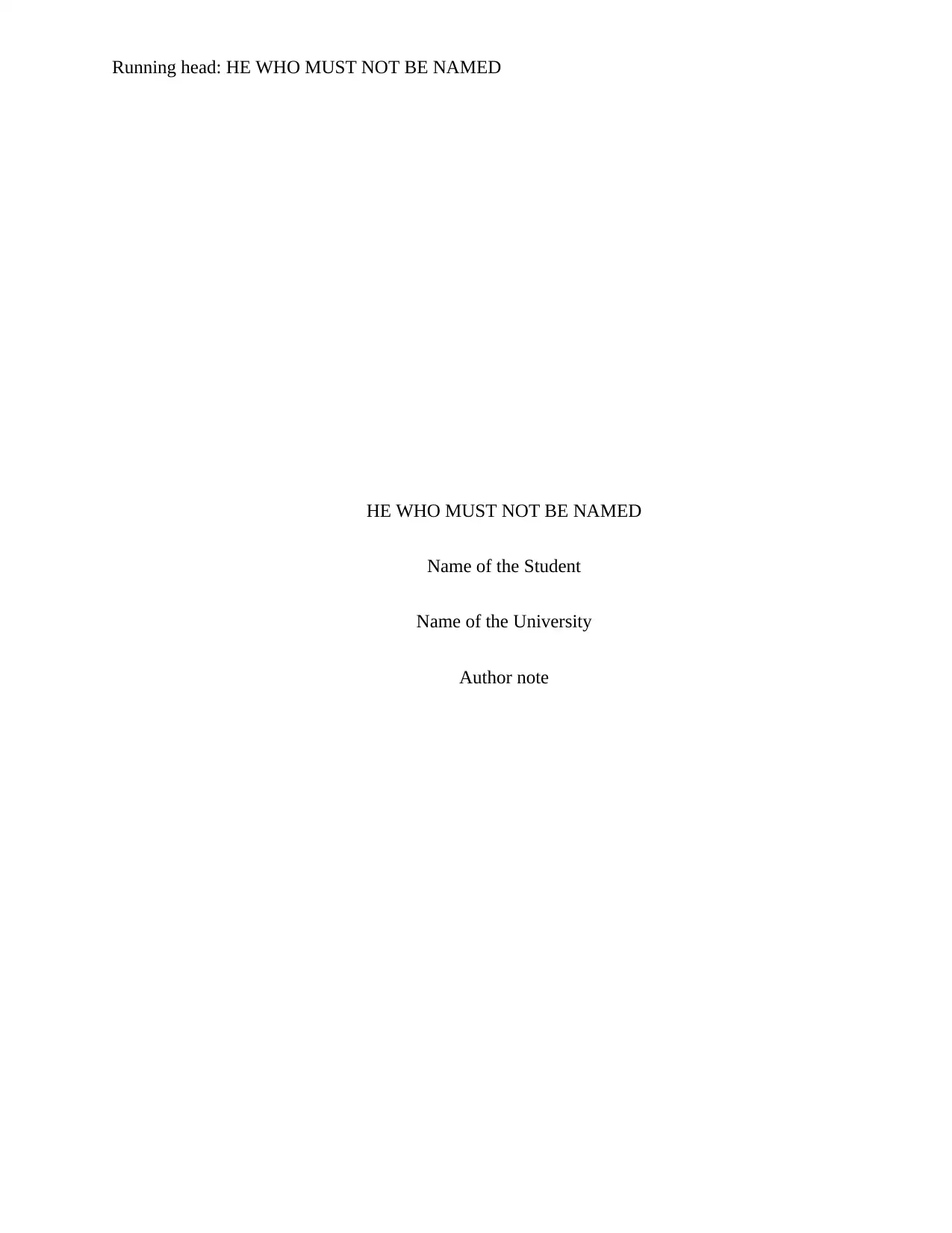
Running head: HE WHO MUST NOT BE NAMED
HE WHO MUST NOT BE NAMED
Name of the Student
Name of the University
Author note
HE WHO MUST NOT BE NAMED
Name of the Student
Name of the University
Author note
Paraphrase This Document
Need a fresh take? Get an instant paraphrase of this document with our AI Paraphraser
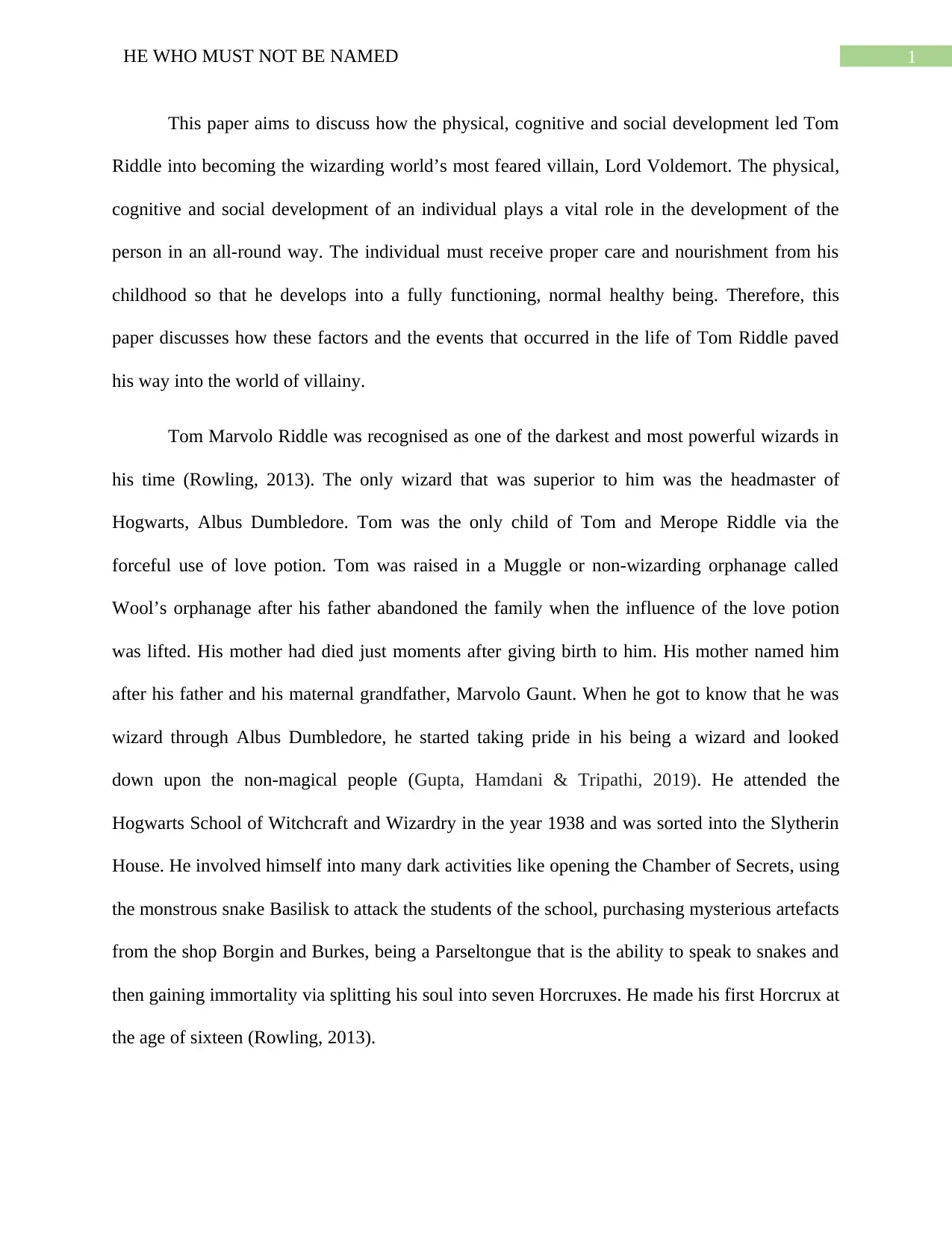
1HE WHO MUST NOT BE NAMED
This paper aims to discuss how the physical, cognitive and social development led Tom
Riddle into becoming the wizarding world’s most feared villain, Lord Voldemort. The physical,
cognitive and social development of an individual plays a vital role in the development of the
person in an all-round way. The individual must receive proper care and nourishment from his
childhood so that he develops into a fully functioning, normal healthy being. Therefore, this
paper discusses how these factors and the events that occurred in the life of Tom Riddle paved
his way into the world of villainy.
Tom Marvolo Riddle was recognised as one of the darkest and most powerful wizards in
his time (Rowling, 2013). The only wizard that was superior to him was the headmaster of
Hogwarts, Albus Dumbledore. Tom was the only child of Tom and Merope Riddle via the
forceful use of love potion. Tom was raised in a Muggle or non-wizarding orphanage called
Wool’s orphanage after his father abandoned the family when the influence of the love potion
was lifted. His mother had died just moments after giving birth to him. His mother named him
after his father and his maternal grandfather, Marvolo Gaunt. When he got to know that he was
wizard through Albus Dumbledore, he started taking pride in his being a wizard and looked
down upon the non-magical people (Gupta, Hamdani & Tripathi, 2019). He attended the
Hogwarts School of Witchcraft and Wizardry in the year 1938 and was sorted into the Slytherin
House. He involved himself into many dark activities like opening the Chamber of Secrets, using
the monstrous snake Basilisk to attack the students of the school, purchasing mysterious artefacts
from the shop Borgin and Burkes, being a Parseltongue that is the ability to speak to snakes and
then gaining immortality via splitting his soul into seven Horcruxes. He made his first Horcrux at
the age of sixteen (Rowling, 2013).
This paper aims to discuss how the physical, cognitive and social development led Tom
Riddle into becoming the wizarding world’s most feared villain, Lord Voldemort. The physical,
cognitive and social development of an individual plays a vital role in the development of the
person in an all-round way. The individual must receive proper care and nourishment from his
childhood so that he develops into a fully functioning, normal healthy being. Therefore, this
paper discusses how these factors and the events that occurred in the life of Tom Riddle paved
his way into the world of villainy.
Tom Marvolo Riddle was recognised as one of the darkest and most powerful wizards in
his time (Rowling, 2013). The only wizard that was superior to him was the headmaster of
Hogwarts, Albus Dumbledore. Tom was the only child of Tom and Merope Riddle via the
forceful use of love potion. Tom was raised in a Muggle or non-wizarding orphanage called
Wool’s orphanage after his father abandoned the family when the influence of the love potion
was lifted. His mother had died just moments after giving birth to him. His mother named him
after his father and his maternal grandfather, Marvolo Gaunt. When he got to know that he was
wizard through Albus Dumbledore, he started taking pride in his being a wizard and looked
down upon the non-magical people (Gupta, Hamdani & Tripathi, 2019). He attended the
Hogwarts School of Witchcraft and Wizardry in the year 1938 and was sorted into the Slytherin
House. He involved himself into many dark activities like opening the Chamber of Secrets, using
the monstrous snake Basilisk to attack the students of the school, purchasing mysterious artefacts
from the shop Borgin and Burkes, being a Parseltongue that is the ability to speak to snakes and
then gaining immortality via splitting his soul into seven Horcruxes. He made his first Horcrux at
the age of sixteen (Rowling, 2013).
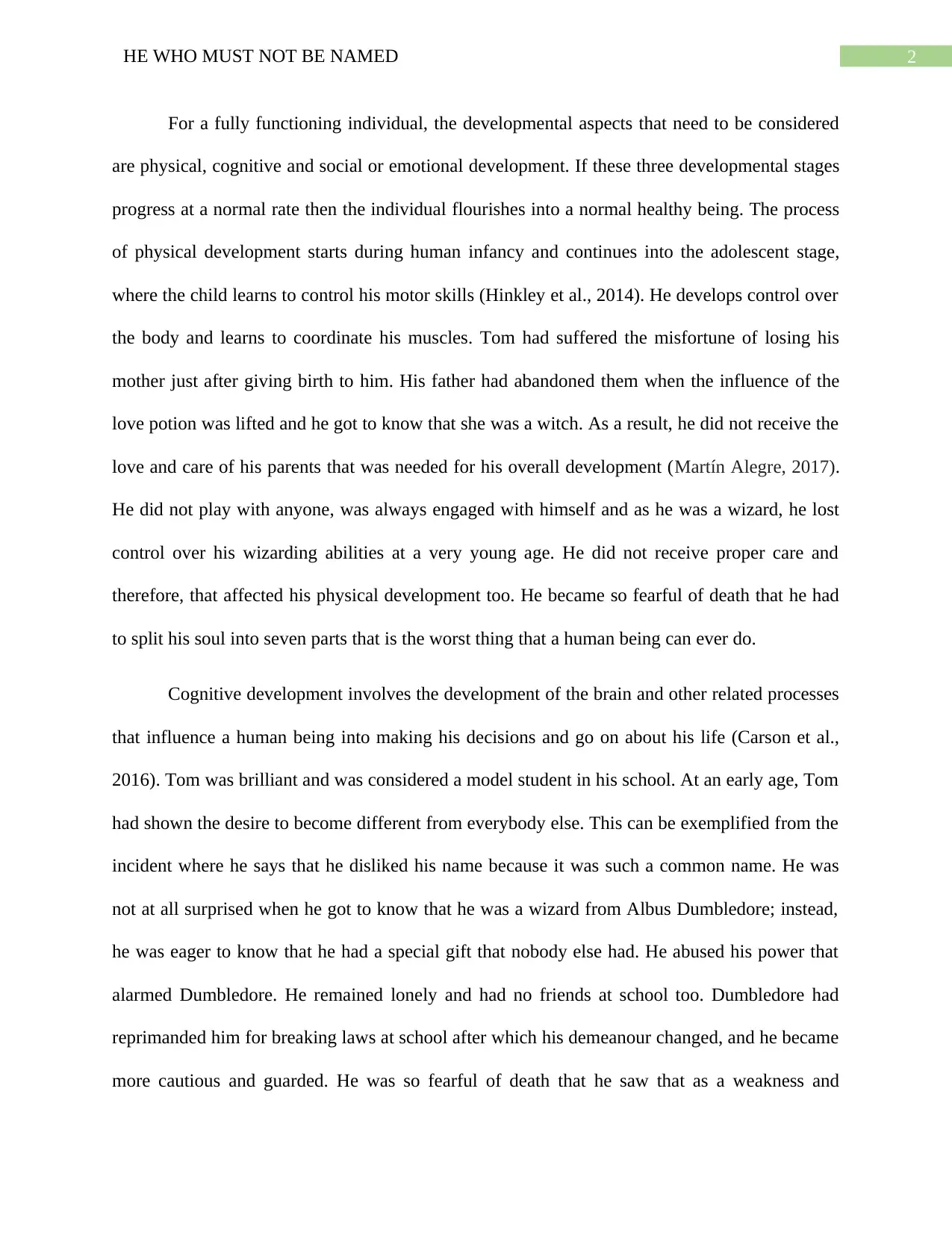
2HE WHO MUST NOT BE NAMED
For a fully functioning individual, the developmental aspects that need to be considered
are physical, cognitive and social or emotional development. If these three developmental stages
progress at a normal rate then the individual flourishes into a normal healthy being. The process
of physical development starts during human infancy and continues into the adolescent stage,
where the child learns to control his motor skills (Hinkley et al., 2014). He develops control over
the body and learns to coordinate his muscles. Tom had suffered the misfortune of losing his
mother just after giving birth to him. His father had abandoned them when the influence of the
love potion was lifted and he got to know that she was a witch. As a result, he did not receive the
love and care of his parents that was needed for his overall development (Martín Alegre, 2017).
He did not play with anyone, was always engaged with himself and as he was a wizard, he lost
control over his wizarding abilities at a very young age. He did not receive proper care and
therefore, that affected his physical development too. He became so fearful of death that he had
to split his soul into seven parts that is the worst thing that a human being can ever do.
Cognitive development involves the development of the brain and other related processes
that influence a human being into making his decisions and go on about his life (Carson et al.,
2016). Tom was brilliant and was considered a model student in his school. At an early age, Tom
had shown the desire to become different from everybody else. This can be exemplified from the
incident where he says that he disliked his name because it was such a common name. He was
not at all surprised when he got to know that he was a wizard from Albus Dumbledore; instead,
he was eager to know that he had a special gift that nobody else had. He abused his power that
alarmed Dumbledore. He remained lonely and had no friends at school too. Dumbledore had
reprimanded him for breaking laws at school after which his demeanour changed, and he became
more cautious and guarded. He was so fearful of death that he saw that as a weakness and
For a fully functioning individual, the developmental aspects that need to be considered
are physical, cognitive and social or emotional development. If these three developmental stages
progress at a normal rate then the individual flourishes into a normal healthy being. The process
of physical development starts during human infancy and continues into the adolescent stage,
where the child learns to control his motor skills (Hinkley et al., 2014). He develops control over
the body and learns to coordinate his muscles. Tom had suffered the misfortune of losing his
mother just after giving birth to him. His father had abandoned them when the influence of the
love potion was lifted and he got to know that she was a witch. As a result, he did not receive the
love and care of his parents that was needed for his overall development (Martín Alegre, 2017).
He did not play with anyone, was always engaged with himself and as he was a wizard, he lost
control over his wizarding abilities at a very young age. He did not receive proper care and
therefore, that affected his physical development too. He became so fearful of death that he had
to split his soul into seven parts that is the worst thing that a human being can ever do.
Cognitive development involves the development of the brain and other related processes
that influence a human being into making his decisions and go on about his life (Carson et al.,
2016). Tom was brilliant and was considered a model student in his school. At an early age, Tom
had shown the desire to become different from everybody else. This can be exemplified from the
incident where he says that he disliked his name because it was such a common name. He was
not at all surprised when he got to know that he was a wizard from Albus Dumbledore; instead,
he was eager to know that he had a special gift that nobody else had. He abused his power that
alarmed Dumbledore. He remained lonely and had no friends at school too. Dumbledore had
reprimanded him for breaking laws at school after which his demeanour changed, and he became
more cautious and guarded. He was so fearful of death that he saw that as a weakness and
⊘ This is a preview!⊘
Do you want full access?
Subscribe today to unlock all pages.

Trusted by 1+ million students worldwide
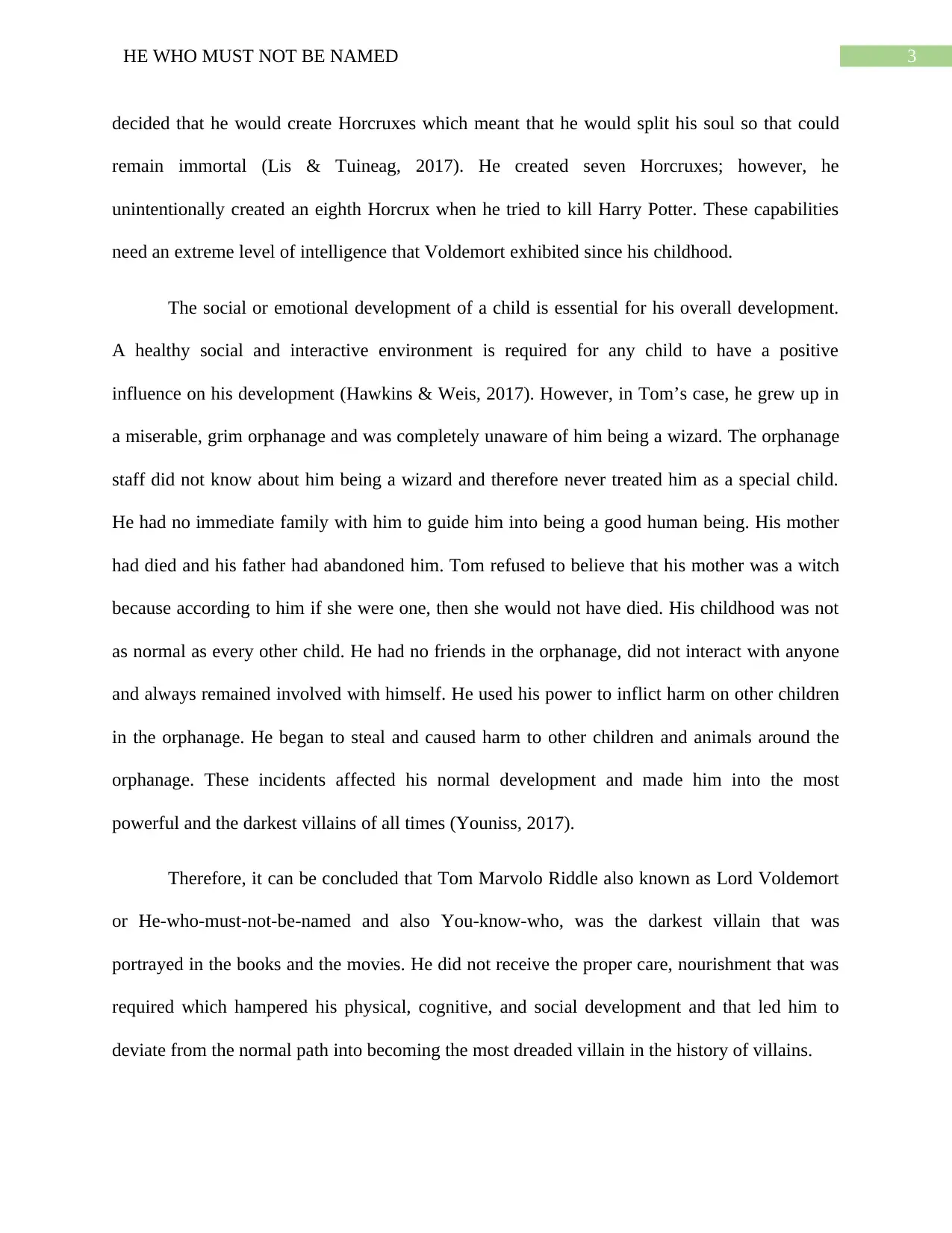
3HE WHO MUST NOT BE NAMED
decided that he would create Horcruxes which meant that he would split his soul so that could
remain immortal (Lis & Tuineag, 2017). He created seven Horcruxes; however, he
unintentionally created an eighth Horcrux when he tried to kill Harry Potter. These capabilities
need an extreme level of intelligence that Voldemort exhibited since his childhood.
The social or emotional development of a child is essential for his overall development.
A healthy social and interactive environment is required for any child to have a positive
influence on his development (Hawkins & Weis, 2017). However, in Tom’s case, he grew up in
a miserable, grim orphanage and was completely unaware of him being a wizard. The orphanage
staff did not know about him being a wizard and therefore never treated him as a special child.
He had no immediate family with him to guide him into being a good human being. His mother
had died and his father had abandoned him. Tom refused to believe that his mother was a witch
because according to him if she were one, then she would not have died. His childhood was not
as normal as every other child. He had no friends in the orphanage, did not interact with anyone
and always remained involved with himself. He used his power to inflict harm on other children
in the orphanage. He began to steal and caused harm to other children and animals around the
orphanage. These incidents affected his normal development and made him into the most
powerful and the darkest villains of all times (Youniss, 2017).
Therefore, it can be concluded that Tom Marvolo Riddle also known as Lord Voldemort
or He-who-must-not-be-named and also You-know-who, was the darkest villain that was
portrayed in the books and the movies. He did not receive the proper care, nourishment that was
required which hampered his physical, cognitive, and social development and that led him to
deviate from the normal path into becoming the most dreaded villain in the history of villains.
decided that he would create Horcruxes which meant that he would split his soul so that could
remain immortal (Lis & Tuineag, 2017). He created seven Horcruxes; however, he
unintentionally created an eighth Horcrux when he tried to kill Harry Potter. These capabilities
need an extreme level of intelligence that Voldemort exhibited since his childhood.
The social or emotional development of a child is essential for his overall development.
A healthy social and interactive environment is required for any child to have a positive
influence on his development (Hawkins & Weis, 2017). However, in Tom’s case, he grew up in
a miserable, grim orphanage and was completely unaware of him being a wizard. The orphanage
staff did not know about him being a wizard and therefore never treated him as a special child.
He had no immediate family with him to guide him into being a good human being. His mother
had died and his father had abandoned him. Tom refused to believe that his mother was a witch
because according to him if she were one, then she would not have died. His childhood was not
as normal as every other child. He had no friends in the orphanage, did not interact with anyone
and always remained involved with himself. He used his power to inflict harm on other children
in the orphanage. He began to steal and caused harm to other children and animals around the
orphanage. These incidents affected his normal development and made him into the most
powerful and the darkest villains of all times (Youniss, 2017).
Therefore, it can be concluded that Tom Marvolo Riddle also known as Lord Voldemort
or He-who-must-not-be-named and also You-know-who, was the darkest villain that was
portrayed in the books and the movies. He did not receive the proper care, nourishment that was
required which hampered his physical, cognitive, and social development and that led him to
deviate from the normal path into becoming the most dreaded villain in the history of villains.
Paraphrase This Document
Need a fresh take? Get an instant paraphrase of this document with our AI Paraphraser
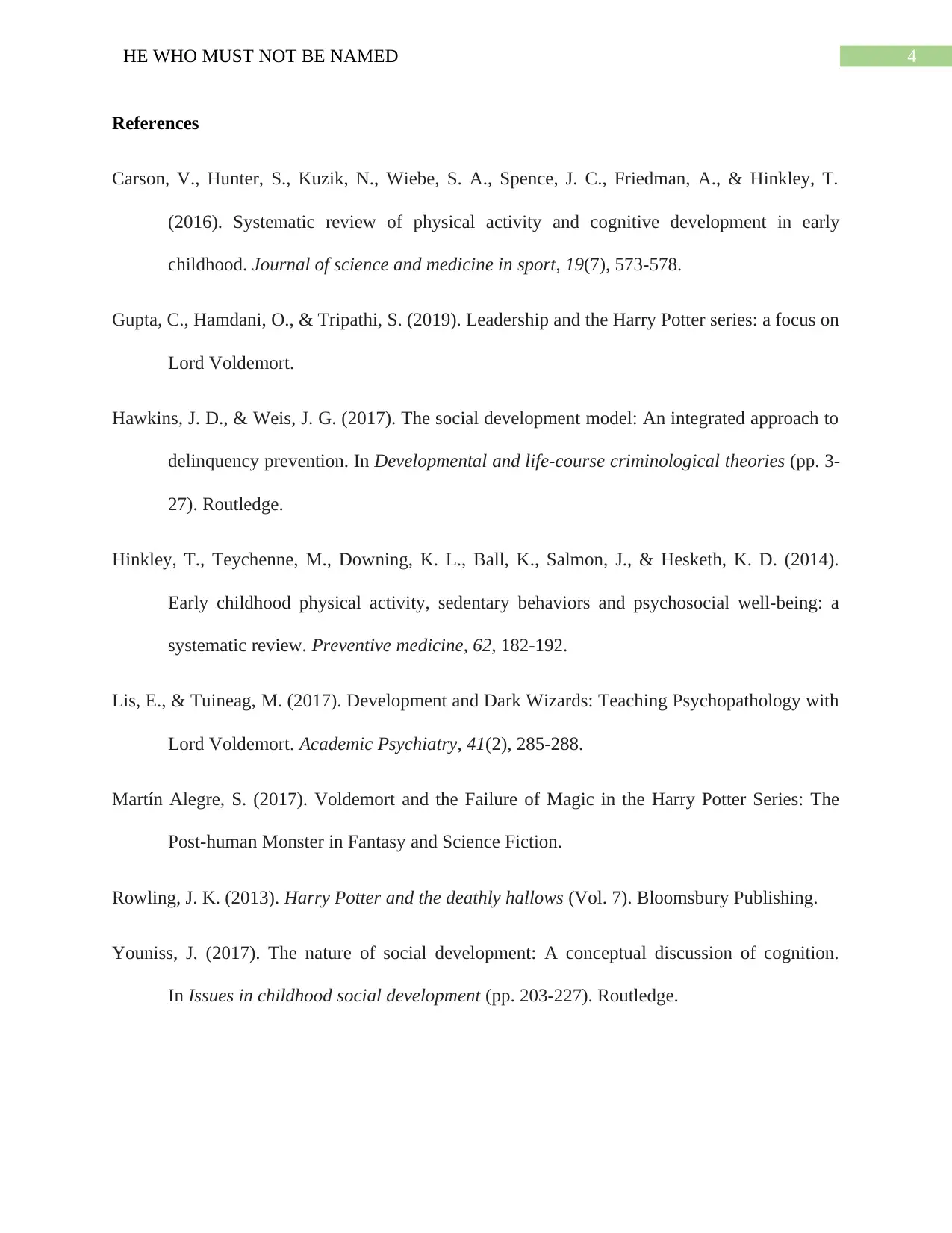
4HE WHO MUST NOT BE NAMED
References
Carson, V., Hunter, S., Kuzik, N., Wiebe, S. A., Spence, J. C., Friedman, A., & Hinkley, T.
(2016). Systematic review of physical activity and cognitive development in early
childhood. Journal of science and medicine in sport, 19(7), 573-578.
Gupta, C., Hamdani, O., & Tripathi, S. (2019). Leadership and the Harry Potter series: a focus on
Lord Voldemort.
Hawkins, J. D., & Weis, J. G. (2017). The social development model: An integrated approach to
delinquency prevention. In Developmental and life-course criminological theories (pp. 3-
27). Routledge.
Hinkley, T., Teychenne, M., Downing, K. L., Ball, K., Salmon, J., & Hesketh, K. D. (2014).
Early childhood physical activity, sedentary behaviors and psychosocial well-being: a
systematic review. Preventive medicine, 62, 182-192.
Lis, E., & Tuineag, M. (2017). Development and Dark Wizards: Teaching Psychopathology with
Lord Voldemort. Academic Psychiatry, 41(2), 285-288.
Martín Alegre, S. (2017). Voldemort and the Failure of Magic in the Harry Potter Series: The
Post-human Monster in Fantasy and Science Fiction.
Rowling, J. K. (2013). Harry Potter and the deathly hallows (Vol. 7). Bloomsbury Publishing.
Youniss, J. (2017). The nature of social development: A conceptual discussion of cognition.
In Issues in childhood social development (pp. 203-227). Routledge.
References
Carson, V., Hunter, S., Kuzik, N., Wiebe, S. A., Spence, J. C., Friedman, A., & Hinkley, T.
(2016). Systematic review of physical activity and cognitive development in early
childhood. Journal of science and medicine in sport, 19(7), 573-578.
Gupta, C., Hamdani, O., & Tripathi, S. (2019). Leadership and the Harry Potter series: a focus on
Lord Voldemort.
Hawkins, J. D., & Weis, J. G. (2017). The social development model: An integrated approach to
delinquency prevention. In Developmental and life-course criminological theories (pp. 3-
27). Routledge.
Hinkley, T., Teychenne, M., Downing, K. L., Ball, K., Salmon, J., & Hesketh, K. D. (2014).
Early childhood physical activity, sedentary behaviors and psychosocial well-being: a
systematic review. Preventive medicine, 62, 182-192.
Lis, E., & Tuineag, M. (2017). Development and Dark Wizards: Teaching Psychopathology with
Lord Voldemort. Academic Psychiatry, 41(2), 285-288.
Martín Alegre, S. (2017). Voldemort and the Failure of Magic in the Harry Potter Series: The
Post-human Monster in Fantasy and Science Fiction.
Rowling, J. K. (2013). Harry Potter and the deathly hallows (Vol. 7). Bloomsbury Publishing.
Youniss, J. (2017). The nature of social development: A conceptual discussion of cognition.
In Issues in childhood social development (pp. 203-227). Routledge.
1 out of 5
Your All-in-One AI-Powered Toolkit for Academic Success.
+13062052269
info@desklib.com
Available 24*7 on WhatsApp / Email
![[object Object]](/_next/static/media/star-bottom.7253800d.svg)
Unlock your academic potential
Copyright © 2020–2025 A2Z Services. All Rights Reserved. Developed and managed by ZUCOL.
